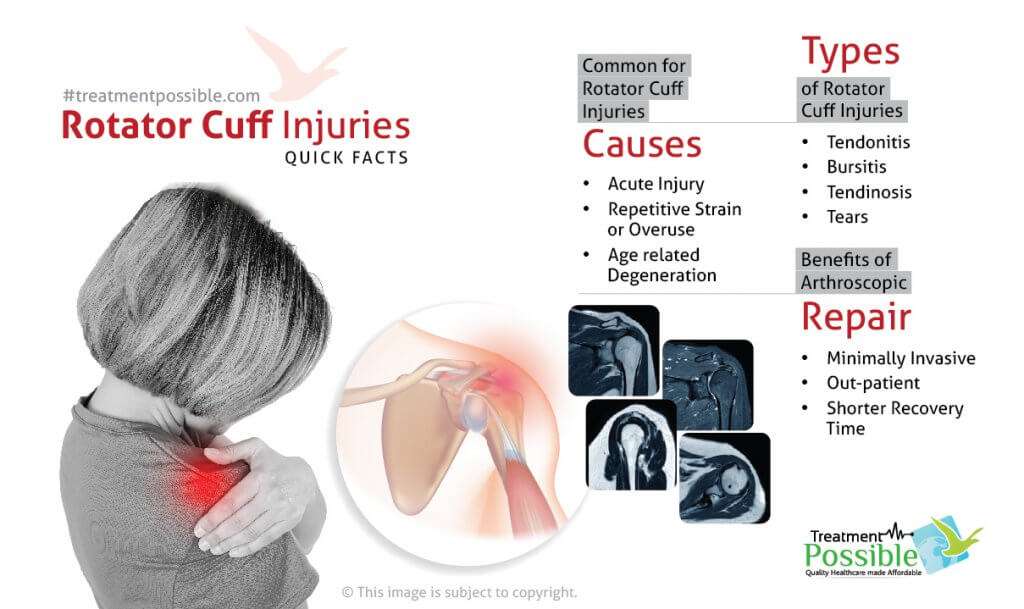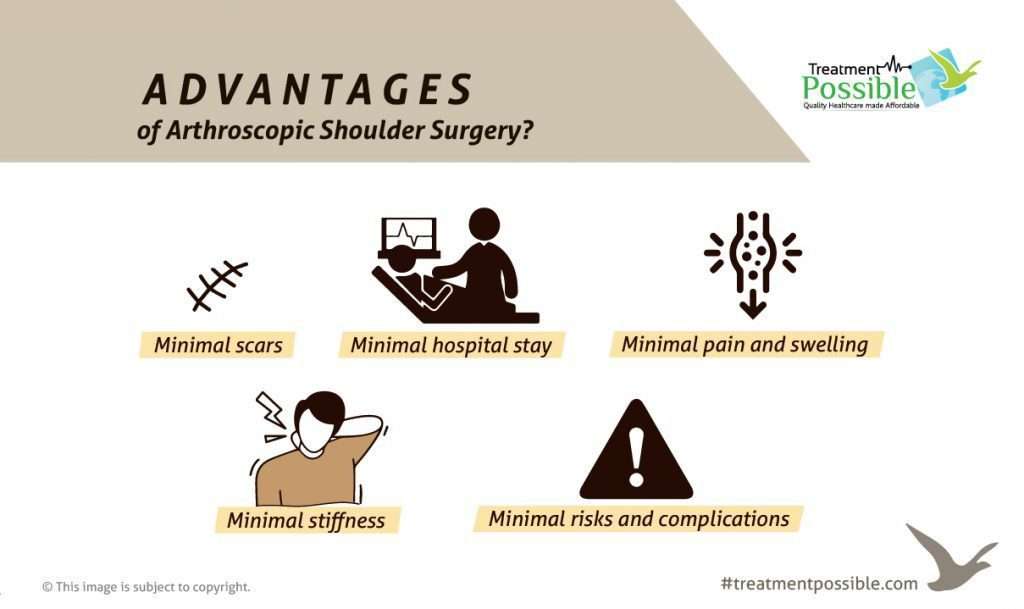What is a Shoulder Arthroscopy Surgery?
Shoulder arthroscopy surgery is a procedure that uses a tiny camera called an arthroscope, to examine or repair the tissues in and around your shoulder joint. The arthroscope is inserted through a small incision in your shoulder joint. An arthroscope is a pencil-sized tool that contains magnifying lenses and a light source. This is attached to a small camera that shows a clear image of the joint on a TV monitor. The surgeon corrects the tendons, muscles, or cartilage, and the tissues that are damaged would be removed. The arthroscope will be removed after the surgical procedure is completed.
A rotator cuff is a group of four muscles that come together as tendons which hold the arm in the shoulder joint. This usually helps the shoulder to move in different directions. The tendons in the rotator cuff can get damaged when they are overused or injured.
Who Requires Shoulder Arthroscopy Surgery?
The rotator cuff can get damaged from an injury to the shoulder. The symptoms are limited ability to move the arm, severe pain in shoulder and muscle weakness. The damage may be due to:
- ROTATOR CUFF TEAR: A rotator cuff tear is when the tendon is torn from the arm bone. A tear may be caused by injury to the shoulder, as well as chronic overuse of the rotator cuff muscles. Obesity and smoking could increase the chances of tearing the rotator cuff.
- TENDONS (TENDINITIS): Rotator cuff tendinitis is most common in young athletes and middle-aged people. This normally occurs when a healthy rotator cuff tendon is injured.
- BURSA (BURSITIS): Repetitive movement or overuse of the shoulder joint.
- ROTATOR CUFF TENDINOSIS: The rotator cuff tendon degenerates due to ageing. This is generally because of decreased blood supply to the rotator cuff tendons.

What Conditions can be Treated with Shoulder Arthroscopy Surgery?
Arthroscopy maybe recommended for following shoulder problems:
- Arthritis
- Bone spurs
- Rotator cuff tears
- Calcific tendonitis tendinitis (calcium deposition in the rotator cuff)
- Torn labarum
- Bursitis
- to remove scar tissues
- to tighten ligament
- A shoulder dislocation (recurrent dislocation of the shoulder)
- to fix shoulder Impingement syndrome (pain on lifting the arm)
- SLAP tears (Superior Labrum Anterior and Posterior.)
- Damage in the biceps tendon
- Frozen shoulder
How is an Arthroscopy Shoulder Surgery Performed?
During the procedure, the surgeon:
Step 1 – The arthroscope is inserted into your shoulder through a small incision. The scope is connected to a tiny camera which allows your surgeon to view the tissues inside your shoulder.
Step 2 – The surgeon inspects all the tissues of your shoulder joint. These tissues include cartilage, bones, tendons, and ligaments.
Step 3 – The surgeon repairs any damaged tissues, he would make 1 to 3 more small incisions and insert the required instruments through them. The damage in a muscle, tendon, or cartilage is fixed. Any damaged tissue is removed.
Want more clarification about medical expense & treatment plan?
Plan for shoulder arthroscopy surgery In India
Get a Free Doctor's OpinionWhatapp UsWhat are the Advantages of Arthroscopic Shoulder Surgery?
- Minimal scars
- Minimal hospital stay
- Minimal pain and swelling
- Minimal stiffness
- Minimal risks and complications

What are the Risks of Arthroscopy Shoulder Surgery?
It is important to fully understand what is required in your post-surgical rehabilitation. The complication may include:
- Damage to the surrounding nerves (which might impair arm movement)
- Infection. All invasive surgery carries a measure of the risk of infection.
- Blood clots. Some procedures that last longer than an hour can increase the risk of blood clots developing in your legs or lungs.
What to Expect after Arthroscopy Shoulder Surgery?
Following the surgery, you should not reach behind your back with your operated arm.
You must not actively move your arm or lift any heavy object for four to six weeks. Recovery time may vary, for some, it may take from 1 month to 2 months. Physical therapy can be initiated after six weeks following surgery.
Care at Treatment Possible:
Treatment Possible is associated with Top Orthopedic Surgeons in India who specialize in affordable Shoulder Arthroscopy Surgery. We only work with Hospitals that are equipped with OT that are compatible with complex Shoulder Arthroscopy surgeries. Not all surgeons can perform advanced Shoulder Arthroscopy Surgery in India so Treatment Possible only associates with orthopedic surgeons in India and Hospitals who are experienced in operating complex Shoulder Arthroscopy cases and ensure a successful surgery.
Treatment Possible shall ensure high-quality Shoulder Arthroscopy Surgery in India while guaranteeing the lowest medical services and surgery cost, especially for Shoulder Arthroscopy Surgery. Our understanding of the Indian Medical Services and Healthcare market and our valued relations with Orthopedic surgeons enables us to provide the treatment at a price that is reasonable, affordable and transparent.
The results of the Shoulder Arthroscopy Treatment in India arranged by us have been mostly positive. It is very important to undergo all the prescribed tests based on medical history so that the doctors can determine the perfect medical solution yet manage to keep surgery cost low.
Get Free Consultation with chosen Top orthopedic Surgeons in India with the hassle-free setup of post-operative recovery care, medical travel & stay during the Medical treatment. Check out more valuable information about Shoulder Replacement Surgery in India by calling and talking to us.
You can also send your medical reports for Shoulder Arthroscopy Surgery to care@treatmentpossible.com for free opinions and suggestions from the best Orthopedic surgeons for Shoulder Arthroscopy Surgery in India. No matter what the health condition, you always get good healthcare options and cost advantage from Treatment Possible.
Our Services
From Treatment To Recovery, We Are Always There With You!

Medical Visa Letter
We provide a Medical visa letter for which we require the scanned passport copies of the patient and attendant.

Arrange An Appointment With A Surgeon
We arrange for the appointment with the surgeon, confirm for the hospital room and operation theatre (if required)

Post Surgery Follow Up
We help you to fix your telephonic appointment for future follow-ups

Complimentary Pickup
We arrange for complimentary pickup and drop services from the airport.

All The Necessary Arrangements
We arrange for hospital admission, forex exchange, sim card and local assistance

No Need To Worry About Essential Expenses!
We help in sorting out the hospital bill, return ticket, medicines and other essential purchases.
Frequently Asked Questions:
Who are eligible for shoulder arthroscopy?
Patients with the below conditions are eligible for shoulder arthroscopy surgery:
- Torn rotator cuff
- Torn or damaged bicep tendon
- Impingement syndrome
- Damaged cartilage ring or ligament
- Loose tissue that needs to be removed
- Bone spur
What are the causes of Shoulder Arthroscopy surgery?
Repeated use of the shoulder can make the tendons in your shoulder swell and leads them to a “catch” on your upper shoulder bone.
When is Arthroscopic Shoulder Surgery recommended?
Arthroscopic shoulder surgery is used to treat shoulder problems like bursitis, tendonitis, arthritis, impingement, rotator cuff tears, labral tears and shoulder dislocation.
What is the difference between open surgery and Shoulder Arthroscopy surgery?
In case a patient has a large rotator cuff tear, then open surgery would be necessary. Few surgeons may prefer open surgery, because it gives them better access to the area being operated on. Open surgery would mean a larger incision and increased risk of infection compared with arthroscopy.


